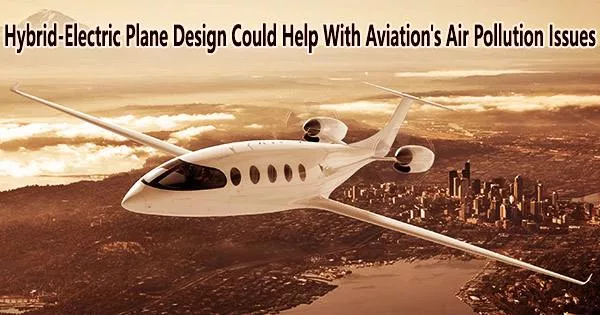Aircraft continuously release nitrogen oxides into the atmosphere at cruising altitude, where the chemicals can stay and create ozone and fine particles. The atmospheric pollutant nitrogen oxides, sometimes known as NOx, has been linked to cardiovascular illness, respiratory disease, and asthma.
Previous studies have revealed that the production of these substances as a result of international flight causes 16,000 preventable deaths annually.
MIT researchers have now developed a theory for airplane propulsion that, according to their estimates, would eliminate 95% of aviation’s NOx emissions and thereby cut the number of related premature deaths by 92 %.
The idea was influenced by emissions-control technologies used in cars used for ground transportation. Today, postcombustion emissions-control systems are installed in a large number of heavy-duty diesel trucks to lessen the NOx that the engines produce. The researchers now propose a similar design for aviation, with an electric twist.
Today’s planes are propelled by jet engines anchored beneath each wing. The propeller on each engine, which is powered by a gas turbine that emits exhaust out the back, propels the plane through the air. Since they would reduce the thrust the engines produce, this arrangement has prevented the installation of emissions-control equipment.
In the new hybrid-electric, or “turbo-electric,” design, a plane’s source of power would still be a conventional gas turbine, but it would be integrated within the plane’s cargo hold. The gas turbine would power a generator, located in the hold, to provide electricity, which would then electrically power the plane’s wing-mounted, electrically powered propellers or fans instead of directly powering them.
The gas turbine’s emissions would be routed into an emissions-control system, which would clean the exhaust before releasing it into the atmosphere. These systems are broadly similar to those used in diesel cars.
“This would still be a tremendous engineering challenge, but there aren’t fundamental physics limitations,” says Steven Barrett, professor of aeronautics and astronautics at MIT. “If you want to get to a net-zero aviation sector, this is a potential way of solving the air pollution part of it, which is significant, and in a way that’s technologically quite viable.”
The journal Energy and Environmental Science has just published the design’s specifics, along with analyses of the prospective fuel costs and health effects. The paper’s co-authors are Prakash Prashanth, Raymond Speth, Sebastian Eastham, and Jayant Sabnins, all members of MIT’s Laboratory for Aviation and the Environment.
The research that’s been done in the last few years shows you could probably electrify smaller aircraft, but for big aircraft, it won’t happen anytime soon without pretty major breakthroughs in battery technology.
Professor Steven Barrett
A semi-electrified plan
Inquiries into the Volkswagen diesel emissions issue by Barrett and his colleagues served as the foundation for the development of the team’s hybrid-electric aircraft.
Environmental authorities learned in 2015 that the automaker had been deliberately tampering with diesel engines to only activate onboard emissions-control systems during lab testing, causing them to appear to meet NOx emissions standards but actually emit up to 40 times more NOx under actual driving circumstances.
As he looked into the health impacts of the emissions cheat, Barrett also became familiar with diesel vehicles’ emissions-control systems in general. Around the same time, he was also looking into the possibility of engineering large, all-electric aircraft.
“The research that’s been done in the last few years shows you could probably electrify smaller aircraft, but for big aircraft, it won’t happen anytime soon without pretty major breakthroughs in battery technology,” Barrett says.
“So I thought, maybe we can take the electric propulsion part from electric aircraft, and the gas turbines that have been around for a long time and are super reliable and very efficient, and combine that with the emissions-control technology that’s used in automotive and ground power, to at least enable semielectrified planes.”
Flying with zero impact
It might have been feasible to put this idea into practice prior to the serious consideration of aviation electrification, for instance as an addition to jet engines. But this design, Barrett notes, would “kill any stream of thrust” that a jet engine would produce, effectively grounding the design.
By separating the gas turbine that generates power from the thrust-producing fans or propellers, Barrett’s design gets around this restriction. Instead, an electric generator that is in turn fueled by the gas turbine would directly power the propellers or fans.
Gas turbine exhaust would be routed into an emissions-control system that could be folded up accordion-style in the cargo hold of the aircraft, fully separate from the thrust-generating propellers.
He envisions the bulk of the hybrid-electric system gas turbine, electric generator, and emissions control system would fit within the belly of a plane, where there can be ample space in many commercial aircraft .
In their new paper, the researchers calculate that if such a hybrid-electric system were implemented on a Boeing 737 or Airbus A320-like aircraft, the extra weight would require about 0.6 percent more fuel to fly the plane.
“This would be many, many times more feasible than what has been proposed for all-electric aircraft,” Barrett says. “This design would add some hundreds of kilograms to a plane, as opposed to adding many tons of batteries, which would be over a magnitude of extra weight.”
Additionally, the researchers estimated the emissions that a large aircraft would emit, both with and without an emissions control system, and discovered that the hybrid-electric design would completely eliminate NOx emissions.
They also predict that 92% of aviation-related pollution-related deaths would be prevented if this technique were implemented on all planes worldwide. They evaluated how much different people across the world would be exposed to these pollutants and used a global model to trace the movement of aviation emissions through the atmosphere. The number of persons who will die as a result of exposure to aircraft pollution was then calculated by converting these exposures to mortalities.
The team is now developing concepts for a “zero-impact” aircraft that doesn’t release NOx or other pollutants like carbon dioxide, which has a negative influence on the climate.
“We need to get to essentially zero net-climate impacts and zero deaths from air pollution,” Barrett says. “This current design would effectively eliminate aviation’s air pollution problem. We’re now working on the climate impact part of it.”
















